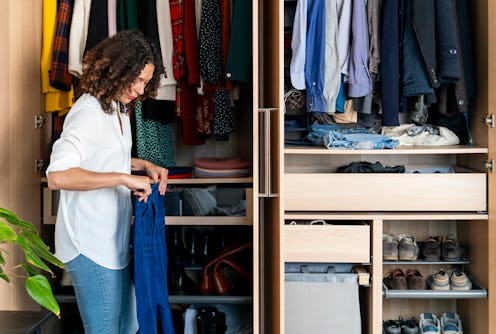Fashion
How To Create A Sustainable Wardrobe, According To Fashion Influencers
Aja Barber, Charlotte Williams & more share their top tips.

Here’s a question few ask themselves: when you look at your wardrobe, are you proud of what’s inside? There are no judgements here. The most common attitude towards shopping is to buy lots and buy often. But at what cost? As we continue to learn more about the devastating effects of fast fashion and throwaway culture, the need for sustainable style feels more important than ever.
This month, in an effort to reduce the amount of clothing ending up in landfills (roughly 13 million items per week), Oxfam is challenging shoppers to exclusively buy secondhand with its new campaign #SecondHandSeptember. But what other practical steps can we take to build a more eco-friendly wardrobe? While we all want to do our bit, ethical style can feel tricky and expensive and many people feel alienated by the concept.
With this in mind, I spoke to five fashion influencers to learn how we can all make better choices. This list comprises people who have mastered the art of ethical shopping as well as those who have only recently begun on their path to sustainability, each of them offering a unique perspective on this complex topic.
1Aja Barber: Find Your Personal Style
For writer, stylist, and sustainability consultant Aja Barber, the journey to ethical consumption starts when you “think about what you're really trying to achieve with your wardrobe.” Barber suggests you “find your personal style” and work from there. That way, you won’t have to buy hundreds of new pieces in an attempt to keep up with the latest trend, you can build a tightly curated collection that works for you.
Barber adds: “Remember that once you slow down and stop buying fast fashion, you'll have more money left over for small brands that you might not have felt you could afford before. Spending £100 on five dresses you will wear once or twice, makes less sense than spending £100 on a dress you'll wear thirty times. You don't need that many dresses, especially not right now in a pandemic.”
2Chloe Helen Miles: Cherish What You Already Own
"Trying to live sustainably can become overwhelming very quickly. “It can make you feel the need to get rid of everything you own and start from scratch but that’s the exact opposite of what you should do to be sustainable,” says Brighton-based style influencer Chloe Helen Miles. “The most sustainable items are the ones you already own, regardless of where they’re from. If something already exists [in your wardrobe], the best thing you can do is look after it and get good use out of it. Sustainability is more attainable than we think because so much of it is about mindset. The core to living sustainably is an appreciation and respect for what you have, where it came from, and who made it.”
3Samio: Start By Making Small Changes
"I’m still on an ongoing journey with being sustainable and it’s definitely evolved over the years,” says Samio, a Manchester-based creative. If you’re just starting out on your path to sustainability, Samio suggests you “start by making small changes that fit with your life as you go.” She continues: “It can be overwhelming if you try to do a full life overhaul all in one go, so take it at a pace that works for you and that you can actually maintain. Use up and utilise what you have when it comes to and products and clothes, then think about what you actually need when purchasing new stuff going forward. All those small changes will add up to big ones in your life over time."
4Charlotte Moore: Try A No-Shopping Month
Ethical style influencer and assistant editor at Restless magazine admits that she used to be somewhat addicted to fast fashion. “I quite literally couldn’t get enough of it,” she tells me. But after realising the effect her shopping habits were having not only her wallet but on the planet also, she decided to go “cold turkey,” promising herself she wouldn’t buy anything new for a month.
"The first month, I felt bereft,” Moore says. “A gaping loss. Shopping was a knee-jerk reaction to sadness, frustration or boredom. But, I soon found that other stuff took up that time. And, I grew to love it. I started buying one thing every two months, picking pieces from slow fashion brands. Yes, they cost more. But, my Stalf Studio trousers have lasted far longer than anything I’ve ever owned from ASOS.”
She continues: “I now pick up new bits on a ‘need to’ basis and that works really for me. But, I think trying out #SecondHandSeptember or even just having a no-shopping month will really change your perspective on the sheer amount of stuff we buy."
5Charlotte Williams: Invest Time In Second-Hand Clothing Apps
Host of the Sustainably Influenced podcast and founder of diversity-focused marketing agency SevenSix, Charlotte Williams explains that she was “raised to be smart with [her] money,” including when it came to fashion. “I would always save up my pocket money and buy a statement piece or hunt through charity shops and car boot sales to get the look I needed for less.”
Williams continues: “As I’ve gotten older this has stuck with me but turned into more of a focus on climate change prevention and ethical consumerism.” One way she does this is by investing time and energy into mastering apps like eBay and Depop. “I buy a lot of Zara pieces from eBay that have been worn once or twice,” she says.
Her advice is to “make sure you set alerts for the items you’re looking for” on the apps and “use filters thoroughly.” Slowly, you’ll begin to master the art of second-hand clothing apps and build a sustainable wardrobe through them.
This article was originally published on